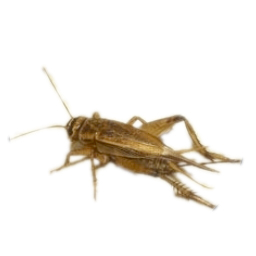The Cricket
The cricket (Acheta domesticus) is often confused with the grasshopper and the locust. They all belong to the Orthoptera order, which is characterized by straight wings. The cricket measures 1.5 to 2.5 cm and has a strong, stocky body. It’s often light chestnut or brown in colour. The cricket’s long, thin antennae are the only characteristic that distinguishes it from the grasshopper and the locust. You can easily confirm their presence by noticing their high leaps or listening to their shrill song.
The lifestyle of the cricket
Habitat
The cricket can be found in fields and clearings, near homes, and even inside them in the winter. Outside, it digs underground tunnels to protect itself from predators. It’s mainly active during the day to take advantage of the heat. It can also be seen in the evenings when the days are hot.
Diet
The cricket eats everything, since it’s omnivorous. It mainly feeds on grass, but it can also enjoy fruit, food residue, animal feed, insects, and dead animals.
Reproduction
Cricket reproduction takes place in the spring and summer. The female can lay 700 to 1,000 eggs. She deposits the eggs in the ground until they hatch. A temperature of about 30 °C is required for the eggs to hatch. For this reason, crickets are usually born outside and then infiltrate homes. The young crickets go unnoticed due to their small size of about 1 mm. They reach their adult size after two weeks.

The risks associated with crickets
Crickets aren’t dangerous to humans. However, their presence is usually very disruptive. If they enter your home and emit their shrill cry, you’ll want to get rid of them quickly. Although rarer, a cricket infestation could devour your fabrics and clothes, among other things. Since it’s not easy to get rid of them, the expert cricket exterminators from ExterminaPro are there to support you. Results guaranteed!

